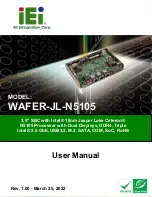
BL4S200 User’s Manual
65
output and a resistor from 50
to 400
, then compile and run the sample program, and
follow the instructions in the Dynamic C
STDIO
window.
•
DAC_RD_CALDATA.C
—Demonstrates how to display the calibration coefficients, gain
and offset, in the Dynamic C
STDIO
window for each channel and mode of operation.
•
DAC_VOLT_ASYNC.C
—Demonstrates how to output a voltage that can be read with a
voltmeter. The output voltage is computed with using the calibration constants that are
stored in the reserved user block.
The D/A converter circuit is set up for asynchronous operation, which updates the D/A
converter output at the time it's being written via the
anaOut()
or
anaOutVolts()
function calls.
Before you compile and run this sample program, connect pins 1–3 and 2–4 on header
JP5, then connect pins 1–2 and 3–4 on both headers JP3 and JP6 (unipolar), or connect
pins 5–6 on both headers JP3 and JP6 (bipolar). Now connect a voltmeter across one of
the D/A converter outputs, then compile and run the sample program, and follow the
instructions in the Dynamic C
STDIO
window.
•
DAC_VOLT_SYNC.C
—Demonstrates how to output a voltage that can be read with a
voltmeter. The output voltage is computed using the calibration constants that are
stored in the reserved user block.
The D/A converter circuit is set up for synchronous operation, which updates the D/A
converter output when the
anaOutStrobe()
function call executes. The outputs will be
updated with values previously written via the
anaOut()
or
anaOutVolts()
function
calls.
Before you compile and run this sample program, connect pins 1–3 and 2–4 on header
JP5, then connect pins 1–2 and 3–4 on both headers JP3 and JP6 (unipolar), or connect
pins 5–6 on both headers JP3 and JP6 (bipolar). Now connect a voltmeter across one of
the D/A converter outputs, then compile and run the sample program, and follow the
instructions in the Dynamic C
STDIO
window.
electronic components distributor






































